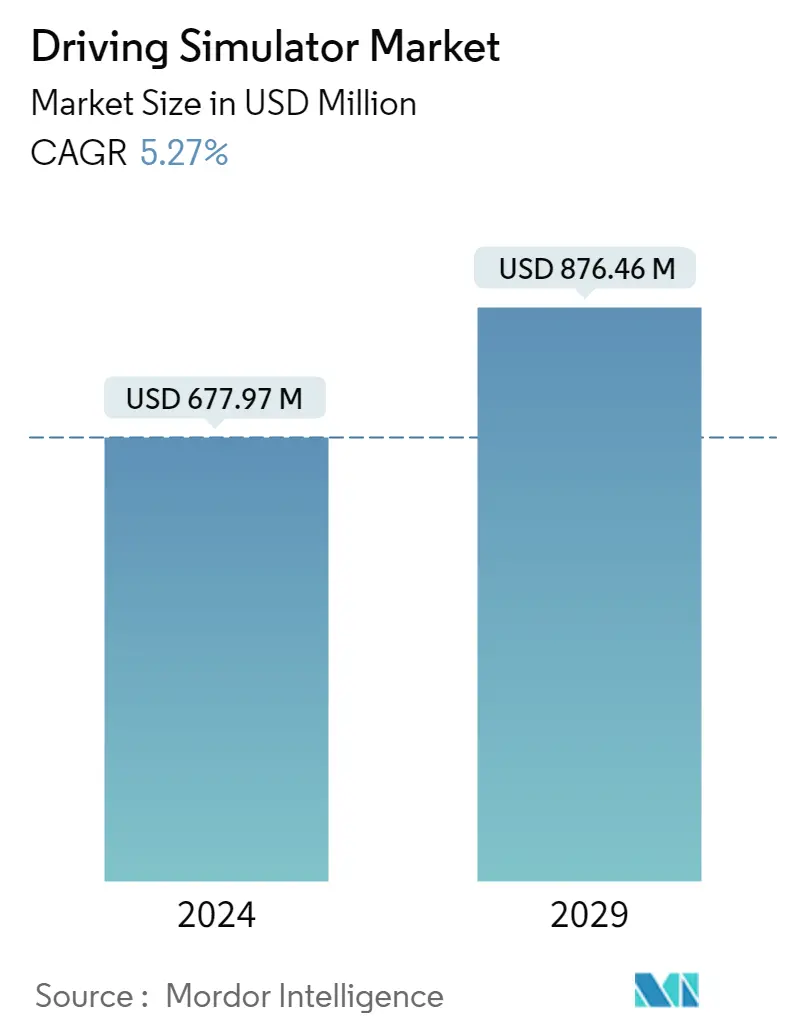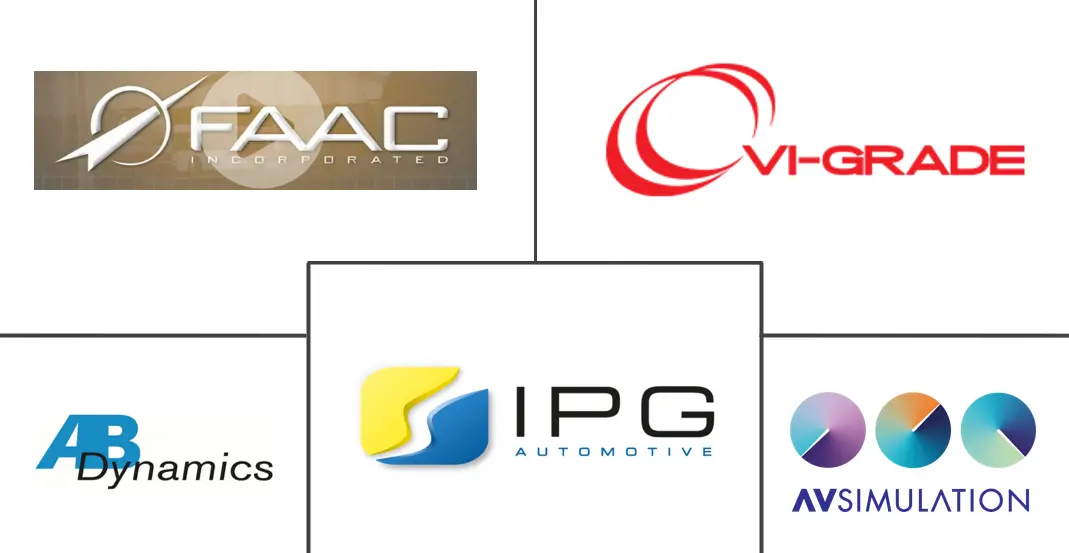Market Size of Driving Simulator Industry

| Study Period | 2019 - 2029 |
| Market Size (2024) | USD 677.97 Million |
| Market Size (2029) | USD 876.46 Million |
| CAGR (2024 - 2029) | 5.27 % |
| Fastest Growing Market | Asia-Pacific |
| Largest Market | Europe |
| Market Concentration | Low |
Major Players
*Disclaimer: Major Players sorted in no particular order |
Driving Simulator Market Analysis
The Driving Simulator Market size is estimated at USD 677.97 million in 2024, and is expected to reach USD 876.46 million by 2029, growing at a CAGR of 5.27% during the forecast period (2024-2029).
Due to the COVID-19 pandemic outbreak and the subsequent lockdowns (with all the restrictions followed), the driver simulator market witnessed a decline. Like any other industry, the pandemic showed a negative impact on the driving simulator market as well. Major countries with a large market share are negatively impacted by the pandemic, reducing the installation of driving simulators. However, as the economies slowly returned to a state of normalcy, the market is picking up pace and is expected to grow positively during the forecast period.
As technologies in automobiles are improving day by day, there is also a significant need for safety features in them. Most accidents happen due to human errors, lack of driving skills, etc. To avoid such situations, driving simulators are the best way to enhance driver skills virtually, where a real-time environment is created artificially. This system helps the driver in managing the situation in a controlled manner. Thus, a driving simulator is more efficient and improves safety to a great extent.
The adoption of driving simulators and analysis technology has experienced an increase in the railways, aviation, marine, defense, and automotive sectors, as it helps in testing and analyzing the designs of products in a virtual environment. Especially in the automobile sector, there is a consistent increase in the demand for advanced safety features in compact and mid-sized automobiles, as most countries are bringing in new laws to improve vehicular safety. Moreover, increasing stringency of safety and environmental regulations has compelled manufacturers and authorities to invest in driving simulators with innovative designs for training. This drastically decreases the research and development cost of the advanced features in a new vehicle.
Simulators are one of the crucial aspects of the development and testing of new vehicles. The simulator's result helps engineers make important decisions by running virtual simulations while building the prototype and testing the vehicle on the track.
Additionally, the electrification of automotive components, the advent of semi-autonomous and autonomous vehicles, and the increasing influence of technology companies in the automotive industry are growth factors for the driving simulator market. The automotive industry is heading toward autonomous vehicles.
Most vehicle manufacturers are working on autonomous vehicle technology, which is not possible without simulators, and in the future, new players are likely to enter the field of autonomous vehicles, which may drive market growth in the forecast period. Major automaker companies, technology giants, and specialist start-ups have invested more than USD 50 billion over the past five years to develop autonomous vehicle (AV) technology, with 70% of the money coming from other than the automotive industry. At the same time, public authorities see that AVs offer substantial potential economic and social benefits.
Driving Simulator Industry Segmentation
Driving simulators are used in driver's education classes provided in educational institutions and by private firms such as driving schools. In the automotive sector, they are also used to create and assess new cars or new advanced driver assistance systems. They are also used for study in the fields of human factors and medical research to monitor driver behavior, performance, and attention.
The driving simulator market is segmented by vehicle type, Application type, simulator type, and Geography.
Based on the vehicle type, the market is segmented into passenger cars and commercial vehicles.
Based on application type, the market is segmented into training, testing, and research.
Based on the simulator type, the market is segmented into compact simulators, full-scale simulators, and advanced simulators.
Based on geography, the market is segmented into North America, Europe, Asia-Pacific, and the rest of the world.
For each segment, the market sizing and forecast have been done based on the value (USD Million).
| By Vehicle Type | |
| Passenger Car | |
| Commercial Vehicle |
| By Application Type | |
| Training | |
| Testing and Research |
| By Simulator Type | |
| Compact Simulator | |
| Full-scale Simulator | |
| Advanced Simulator |
| By Geography | |||||||
| |||||||
| |||||||
| |||||||
|
Driving Simulator Market Size Summary
The driving simulator market is poised for significant growth over the forecast period, driven by advancements in automotive technology and the increasing need for enhanced safety features. The market experienced a temporary setback due to the COVID-19 pandemic, which disrupted installations and slowed down growth. However, as global economies stabilize, the market is rebounding, with driving simulators becoming essential tools for improving driver skills and safety. These simulators create realistic driving environments that help mitigate human errors, a leading cause of accidents. The demand for driving simulators is particularly strong in sectors such as automotive, aviation, marine, and defense, where they are used for testing and analyzing product designs in virtual settings. The automotive industry, in particular, is witnessing a surge in demand for advanced safety features, spurred by new regulations aimed at enhancing vehicular safety.
The market is further bolstered by the electrification of automotive components and the rise of semi-autonomous and autonomous vehicles, which require extensive testing and data collection. Major automotive manufacturers and technology companies are heavily investing in driving simulator technology to support the development of autonomous vehicles, which are expected to offer superior safety compared to human drivers. This trend is accompanied by strategic partnerships and acquisitions among key players in the market, aimed at enhancing simulation capabilities and expanding market presence. Notable developments include the acquisition of simulation companies by major automotive and technology firms, as well as collaborations to develop advanced driving systems. The European market, particularly Germany, is experiencing rapid growth due to its technological advancements and investments in autonomous vehicle technology. Overall, the driving simulator market is set to expand significantly, driven by technological innovations and the increasing focus on safety and automation in the automotive industry.
Driving Simulator Market Size - Table of Contents
-
1. MARKET DYNAMICS
-
1.1 Market Drivers
-
1.2 Market Restraints
-
1.3 Industry Attractiveness - Porter's Five Forces Analysis
-
1.3.1 Threat of New Entrants
-
1.3.2 Bargaining Power of Buyers/Consumers
-
1.3.3 Bargaining Power of Suppliers
-
1.3.4 Threat of Substitute Products
-
1.3.5 Intensity of Competitive Rivalry
-
-
-
2. MARKET SEGMENTATION (Market Size in Value - USD Million)
-
2.1 By Vehicle Type
-
2.1.1 Passenger Car
-
2.1.2 Commercial Vehicle
-
-
2.2 By Application Type
-
2.2.1 Training
-
2.2.2 Testing and Research
-
-
2.3 By Simulator Type
-
2.3.1 Compact Simulator
-
2.3.2 Full-scale Simulator
-
2.3.3 Advanced Simulator
-
-
2.4 By Geography
-
2.4.1 North America
-
2.4.1.1 United States
-
2.4.1.2 Canada
-
2.4.1.3 Rest of North America
-
-
2.4.2 Europe
-
2.4.2.1 Germany
-
2.4.2.2 United Kingdom
-
2.4.2.3 France
-
2.4.2.4 Rest of Europe
-
-
2.4.3 Asia-Pacific
-
2.4.3.1 China
-
2.4.3.2 India
-
2.4.3.3 Japan
-
2.4.3.4 South Korea
-
2.4.3.5 Rest of Asia-Pacific
-
-
2.4.4 Rest of the World
-
2.4.4.1 Brazil
-
2.4.4.2 United Arab Emirates
-
2.4.4.3 Other Countries
-
-
-
Driving Simulator Market Size FAQs
How big is the Driving Simulator Market?
The Driving Simulator Market size is expected to reach USD 677.97 million in 2024 and grow at a CAGR of 5.27% to reach USD 876.46 million by 2029.
What is the current Driving Simulator Market size?
In 2024, the Driving Simulator Market size is expected to reach USD 677.97 million.

